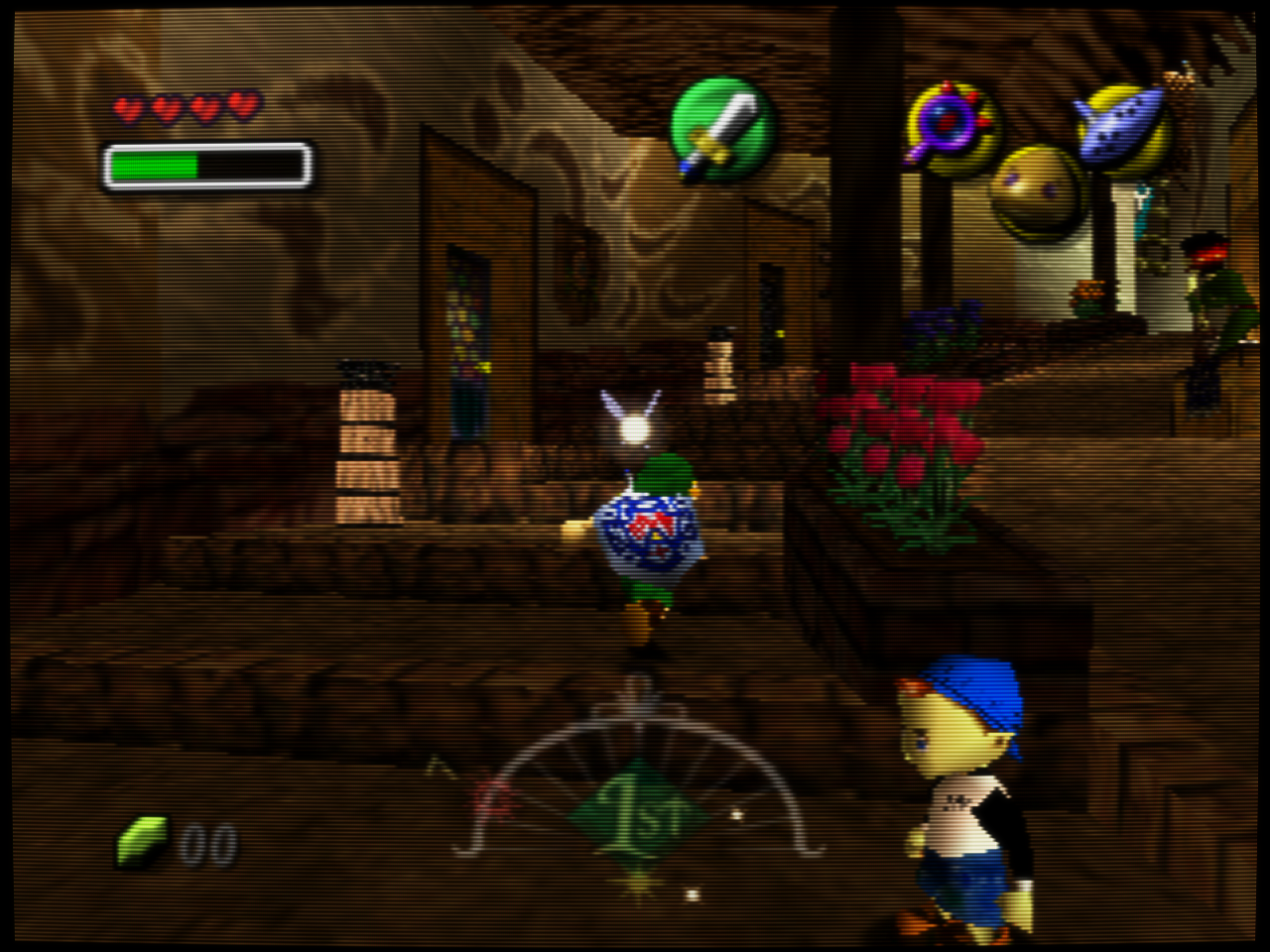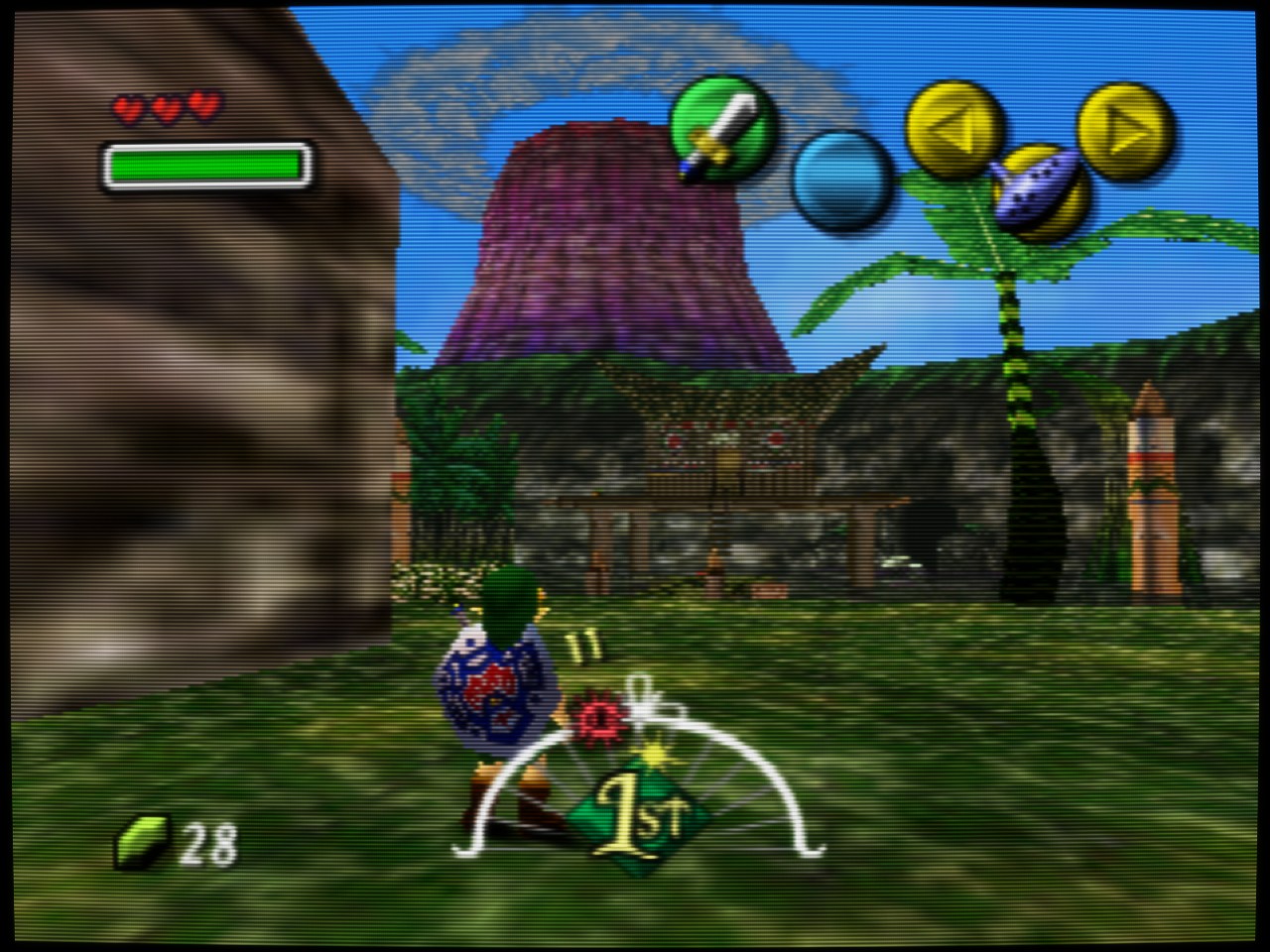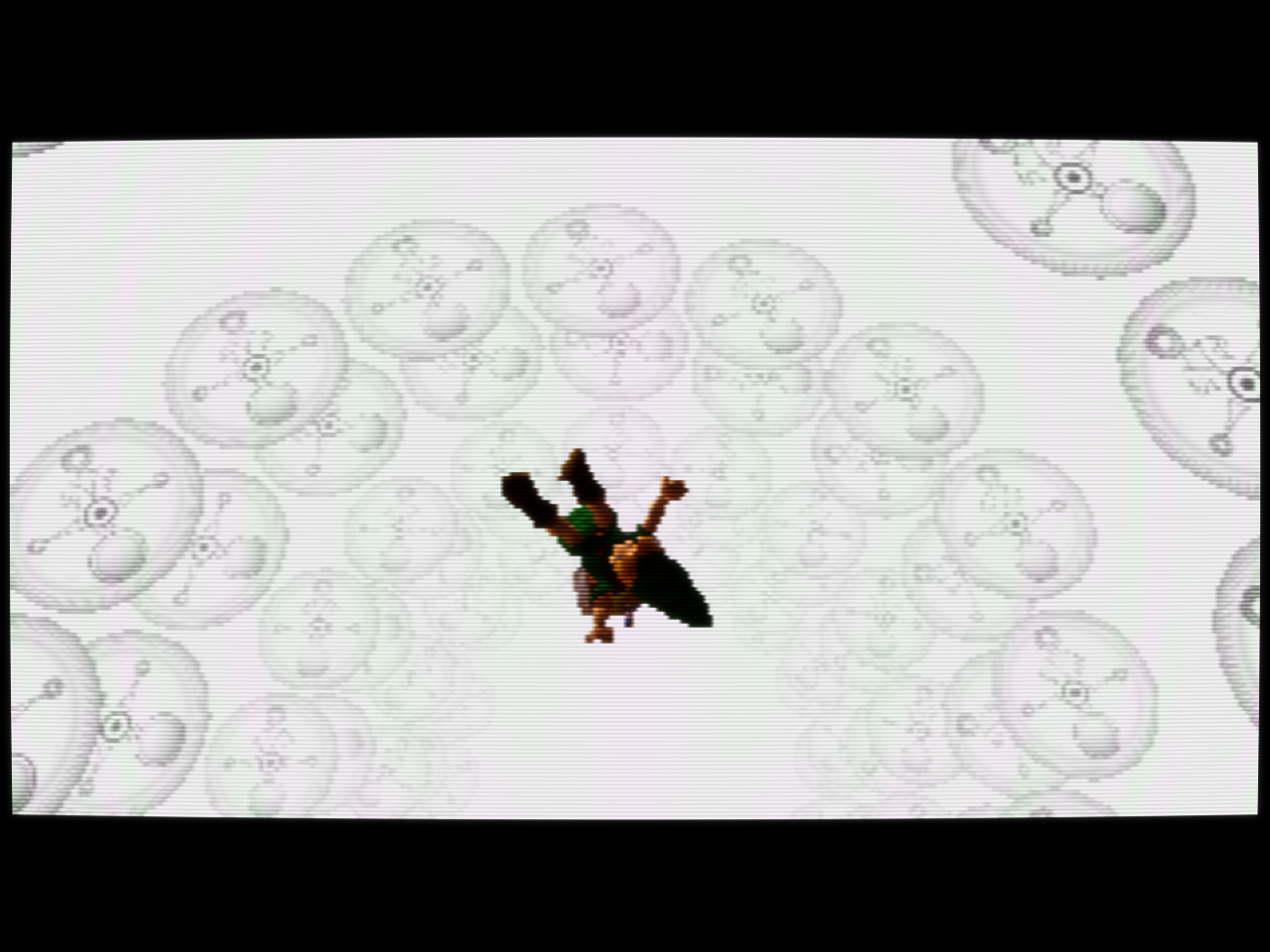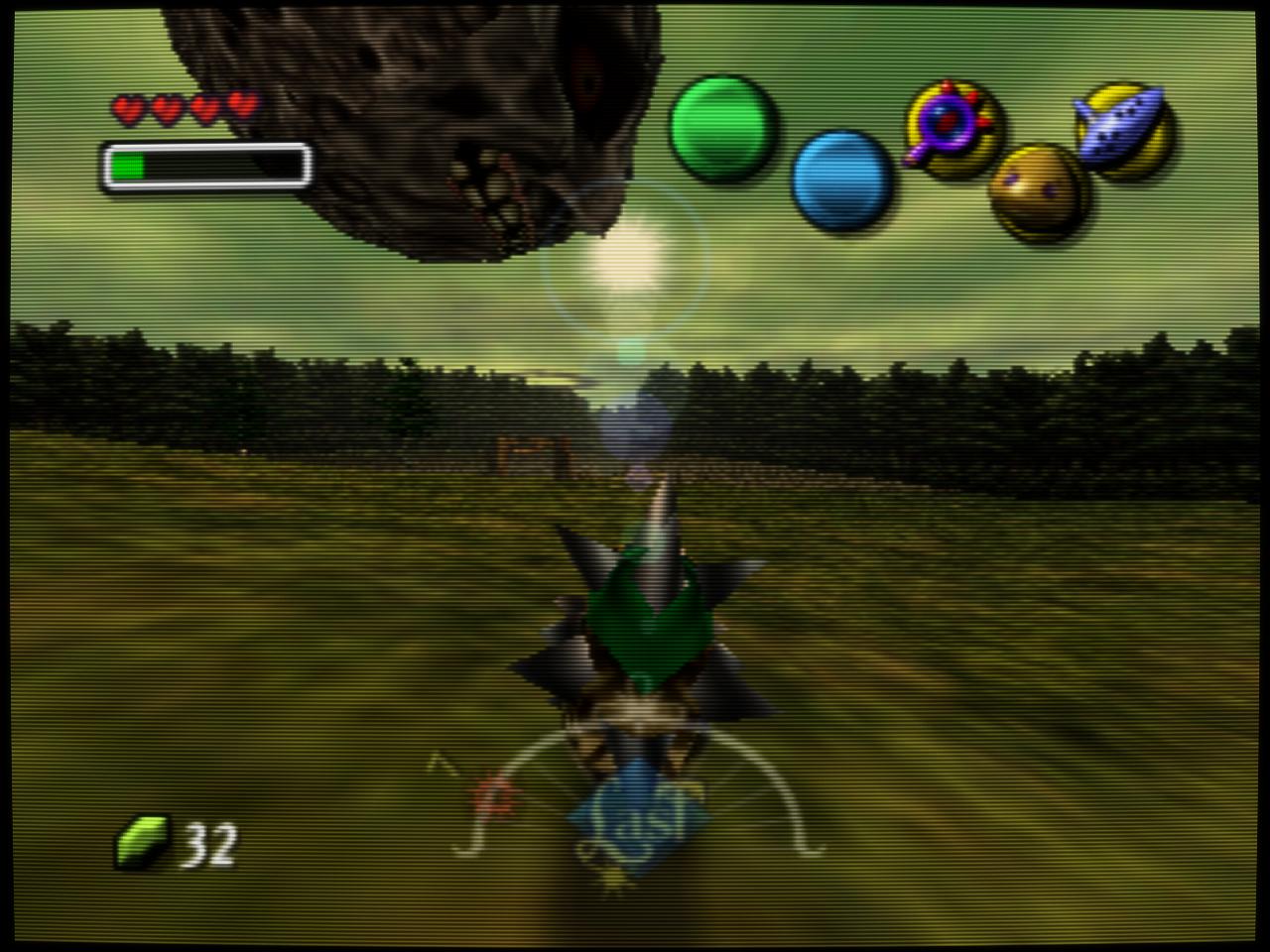Zelda no Densetsu: Majora no Kamen is the result of an experiment within Nintendo and a personal challenge to Eiji Aonuma and his team to begin creating yearly installments of the Zelda series. Despite the massively popular Toki no Ocarina taking three years to make, the sequel would only be given a fraction of that time. Although this admirable commitment to delivering a steady stream of great games is openly ridiculed today, it was nevertheless the determining factor behind what is widely regarded as the most innovative and most interesting Zelda game ever made.
In order to create a game with a comparable scale to Ocarina, Nintendo designed Majora with a smaller world that would make up for it by operating according to an internal schedule over the course of three real-time game days, giving it a greater sense of depth and realism than the artificially static Zelda worlds from previous games. This was a bold step forward for the series as it finally began to distance itself from the early Famicom framework that presented a world whose every piece was a part of a logic puzzle, and thus had to be fixed in-place. In order to adhere to such a rigid framework, a designer has to figuratively scoop out the brains of his created world, mummify it, and prioritize gilding the sarcophagus. But true vitality, instead, comes from games that are allowed to breath — that live alongside the player in a real-time simulation that doesn’t deny reality, but embraces it in all its splendid glory.
As usual, you play as Link, and your goal this time is stop the falling moon from crashing into Clock Town. You’ve only got three days. In order to have any hope of preventing this disaster, you’ll be using your ocarina of time to constantly reset the world and fall back to the beginning of the first day, giving you the means to gather everything you’ll need in time to take down the cursed-mask-wearing kid controlling the moon. Honestly, I find the concept irresistible, and I love the design philosophy of growing a world via depth. Unfortunately though, this game does a rather poor job at delivering the kind of experience you might expect from such a promising premise.
The most severe shortcoming remains the same as it did before from Ocarina — the game is still far too heavily rooted in its Super Famicom predecessor, Kamigami no Triforce. After having made the jump to 3D, Nintendo failed to critically consider anything beyond the transition’s aesthetic implications. All they did was copy over a simplified movement system from Super Mario 64 and slap it together with a version of Kamigami no Triforce that had been brute-forced into 3D. But it’d be premature to judge it too harshly on that account. What Ocarina excelled in and what really set it above its SFC predecessor was the way in which it captured the imagination with its outstanding graphics and the way its world opened up in three dimensions all around you, fully engulfing its players and eliminating the sharp, boxy edges of the screen that had constrained the previous games. It’s a very powerful effect, and one not to be taken lightly. Under the right conditions, Ocarina can appear downright miraculous. It’s unfortunate then that Nintendo didn’t do anything more, since now everything about the N64 Zelda games is antiquated and the result of an uncritical obsession with dragging classic, yet outdated, designs into an era where 3D technology is now making possible the most amazing kinds of games thought possible. Failing to take advantage of the possibilities that games like Biohazard, Metal Gear Solid, and Shenmue have shown the world is nothing less than a refusal to acknowledge the infinite potential of the medium and to practically guarantee your future irrelevance.
To its credit, at least Majora attempted a more progressive design. But by the time it was released it had already been eclipsed by the likes of Shenmue, which also featured a real-time clock that controlled every NPC’s schedule and major event in the game. It even had its own internal countdown to the apocalypse (wait long enough and Lan Di pays YOU a visit). But the greatest difference between the two was the strictly linear progression of events in Shenmue. Of course, this shouldn’t surprise us. After all, Ryo doesn’t own any time machines or magical ocarinas. His is a world more firmly grounded in reality.
But this isn’t just an aesthetic difference. Observe the implications of this design through each game’s NPCs. The linear design philosophy of Shenmue resulted in far more interesting character interactions since nearly everyone had new, fully-voiced things to say whenever you talked with them. It was an incredible thing to see the whole cast responding intelligently to the events going on around them. Sometimes you’d even drop by just to see how some of them were doing, as was the case with anyone with a heart who found themselves passing by Aida Florist. Instead, Majora has a very cyclical time structure that 100% guarantees your interactions with the people in Termina will be repeated over and over again. And once you’ve bled all the information out of a character needed to get a heart piece, mask, or stamp, there’s never any reason for you to ever talk with him again.
The continual clock-resetting is the chief culprit in sapping the NPCs of their vitality. Your first moments in Clock Town, with everyone going about their business, while there’s still some mystery in the air, the game is at its highest point. But as you gradually begin to master each character’s individual routine via the clock-reset, one by one, they cease to exist for the player. Given enough repetitions, the very design of the game itself starts killing off its own NPCs. So for all the praise this game gets for having incredible NPCs, in the end, it’s all for nothing once they’ve all been reduced to algorithms and notebook stamps. Although admittedly, Majora offers an improvement over the near-instant death that the traditional NPC suffers after saying his piece in previous Zelda games, it’s still far behind what was achieved with Shenmue. What we have instead is just another set of optional mini-games masquerading as character interaction that does little to help you in your quest to prevent the moon from falling.
That’s all I care about in this game. I look up into the sky, and I see the moon’s menacing face looking down at me, slowly creeping ever closer to Termina’s ultimate destruction. It’s quite a powerful sight, and I love that you can almost always catch a decent view of the moon outside from wherever you are. What you’ll actually be doing most of the time feels so far removed from your real objective that it’s nice to have these reminders show up every now and then. In fact the atmosphere and setting here is so excellent that it feels sorely wasted on a Zelda game. Everything else being roughly the same, it’s this atmosphere that really sets Majora over and above Ocarina as the best N64 Zelda game.
The non-dungeon music in particular does a fantastic job conveying it. You’re welcomed at first to the world of Termina with the lazy, yet whimsical, Clock Town theme, but as the days slip by the tempo quickens to an unbearable frenzy, which is such an uncomfortable and frantic sound that upon hearing it, I can’t help but to reset the clock in order to escape into a more pleasant soundtrack. Now not every area has had such careful attention paid to its background music, but at least the Clock Town theme is exceptionally well done. The dungeon music is rather lousy, but the rest of the new music in the game is good, with the Majora theme being especially noteworthy. It almost sounds exactly like what you’d expect a hexing ceremony to sound like. Pretty unnerving stuff.
The mandatory memory expansion pack also helps to deliver much better graphics and animations than the last game did. It’s immediately obvious when booting up the game for the first time and actually seeing an opening cutscene with complex actions unlike anything seen before in Ocarina. The final boss fight in particular is quite an amazing thing to see. You’ll also no longer be coming across blurry 2D placeholder sets in the marketplace or small rooms anymore. Everything is now fully rendered in 3D and with a noticeably greater draw distance. The environments are mostly the same from before including a forest area, an ice area, a mountain area, and a water area, but sadly nothing quite like the memorable Jabu-Jabu Belly dungeon made it into the game this time around. But perhaps what’s most disturbing of all is the rampant reuse of assets throughout the entire game, particularly the character models. It’s obvious why they had no choice but to reuse them, but still it’s not something that can easily be ignored. Especially when you think you’ve recognized an old friend, only to find an identical stranger.
Much has also been said about the story and how dark and horrific it is compared to previous Zelda games. In the sense that the story is no longer about rescuing a princess, but rather about preventing a horrible catastrophe that kills everyone, then yes I suppose it is a bit darker than previous games. But really the only horror the game has to offer is the possibility that you’ll have to redo a large chunk of progress made in a dungeon because you ran out of time, requiring you to resolve all those terrible Zelda puzzles and redo all those boring fights all over again from scratch. If there’s only one thing I can say in favor of Ocarina, it’s that it never put your progress in jeopardy like this. Now that’s not to say that this idea in general is a bad one. It’s just that within a Zelda game, this mechanic is incredibly infuriating and almost certainly doesn’t belong here alongside the rest of the game’s systems.
There’s only a single worthwhile point in the game that takes advantage of this mechanic. This is during the very first section of the game when you’re stuck in your Deku form and finally confront the Skull Kid that ruined your day in the opening cutscene. A countdown timer pops up on the bottom of the screen as the fight begins atop the highest tower, the moon bearing down on you overhead, certain to fall at any moment. It’s an intense scene that sends your mind racing, “How am I going to get out of this one?” If you fail, you’ll have to start the whole game over again. During the fight, you manage to take back your ocarina, and with the clock running out, you quickly play the Song of Time. As soon as you do, the screen goes white and you fall back in time and into the game’s one beautiful moment. It’s hard not to be moved by the way you blink the confusion from your eyes after landing from the time jump, while the morning music plays its welcoming tune and fades into the Clock Town theme. And there you are. Back in the center of town on the first day. At this point, it’s easy to become overwhelmed by the idea that you just might be playing something special. Tons of little ideas start going off in your head, and you cheerily proceed along in the hope that the game will meet those expectations.
It’s a real shame then that the time mechanics in Majora are, despite everything you might have heard to the contrary, an incredibly minor part of the game. So minor, they could have easily been removed. Let me tell you how you’ll probably end up playing the game for real. Start up the game. Immediately slow time down with the Inverted Song of Time. This gives you a full three hours to complete your current goal. This usually involves hunting for owl statues, which function as warp points to dungeon entrances. So eventually you find one and hit it with your sword. Now warp back to town. Deposit your rupees in the bank. Then reset the clock. Slow time down again. Fly to the statue you just found. Go in the nearby dungeon and beat the boss. Leave the dungeon. Warp to town. Deposit your rupees. Reset the day. Hunt for the next owl statue with your recently acquired dungeon item. Repeat until done.
After a while of doing this, a sudden revelation may strike, “Hold on a second, I just ended up playing this like any old Zelda game!” The only points at which time factors into anything significant is when you’re waiting for the door to the final boss to open up at midnight on the final day, and occasionally when you’re doing one of the optional, boring NPC side quests. Apart from those minor differences, Majora plays an awful lot like Ocarina.
The only other remarkable difference is that the equipment / tunic system has been replaced with masks. This is great because now all your ability-altering items can be assigned to a C-button, eliminating the need to constantly go in and out of the menu during a dungeon that requires extensive ability swapping, the classic example of which being the Water Temple from Ocarina. The minor masks, obtainable via the side quests, don’t do much though and aren’t very interesting. Some are really only good for a laugh. The important ones are those that transform you into a different creature, either a Deku, Goron, or a Zora. And they’re mostly just for getting past obstacles that require mask-specific abilities, such as swimming as a Zora, or rolling as a Goron. One particular joy of note is just how much fun it is to roll up as a Goron, charge up to a full speed blast, and take off in a mad, spinning dash through the field. It’s a great feeling up until a precise maneuver or turn is suddenly required, which usually ends with you accidentally bouncing against a wall or something and losing control while coming to a miserable stop. But it was fun while it lasted. Everything else about the transformation masks is either unnecessary or just plain unpleasant, and you won’t enjoy wearing them except as a means to make progress.
But one final aspect that settles the issue for good as to which is the better Zelda is the stray dungeon fairies. Each dungeon contains 15 of them, and as soon as you realize just how many there are and that they’re completely optional, you’ll quickly give up on collecting them all. But here’s the genius part. Think of the dumbest, the most deeply rooted and asinine Zelda puzzle that you’ve ever seen, and there’s a 100% chance that it’ll show up somewhere in Majora, however, and this is the best part, they tend to only show up as dungeon fairy puzzles. In other words, the dungeon fairies are where Nintendo hid away all the terrible puzzles and sequences a normal player would never want to do. Hey, don’t want to kill every enemy you see in the hopes that a magic treasure chest will suddenly appear out of nowhere? If you don’t want a dungeon fairy, you don’t have to do it! Don’t want to break every box in the dungeon looking for a key? Don’t sweat it. Only dungeon fairies will be hiding in there. Best of all, if you’re having trouble getting a treasure chest, just check it for golden markings. If it doesn’t have any and is just a plain old wooden chest, then all you’re likely to find in there is a fairy. Skip it if you want!
I can’t even begin to tell you how grateful I am that the game implemented something so accommodating as this. Hey, if you really want to dig deep and visit the dungeons over and over again and squeeze every last drop of juice out of them, you can go nuts collecting all the dungeon fairies. But if you couldn’t care less about those fairies, no problem! Just ignore them. All they do is give you some special powers that might make some of the fights slightly easier. But fights are already easy enough as it is, so fairies aren’t worth collecting unless you’re hellbent on getting absolutely everything in the game.
So if you enjoyed Toki no Ocarina and want more Zelda, then you really cannot go wrong with playing through Majora no Kamen. Consider it an expansion pack, and you won’t be disappointed. But if you’re a newcomer to the series or are just interested to see what the game does with its real-time clock mechanic, there’s not enough here to recommend it over games that really take this concept and run with it. Even with the setting and atmosphere being as good as it is, there’s just not enough here to make it worth playing if you don’t already happen to be a diehard Zelda fan.
★★★




